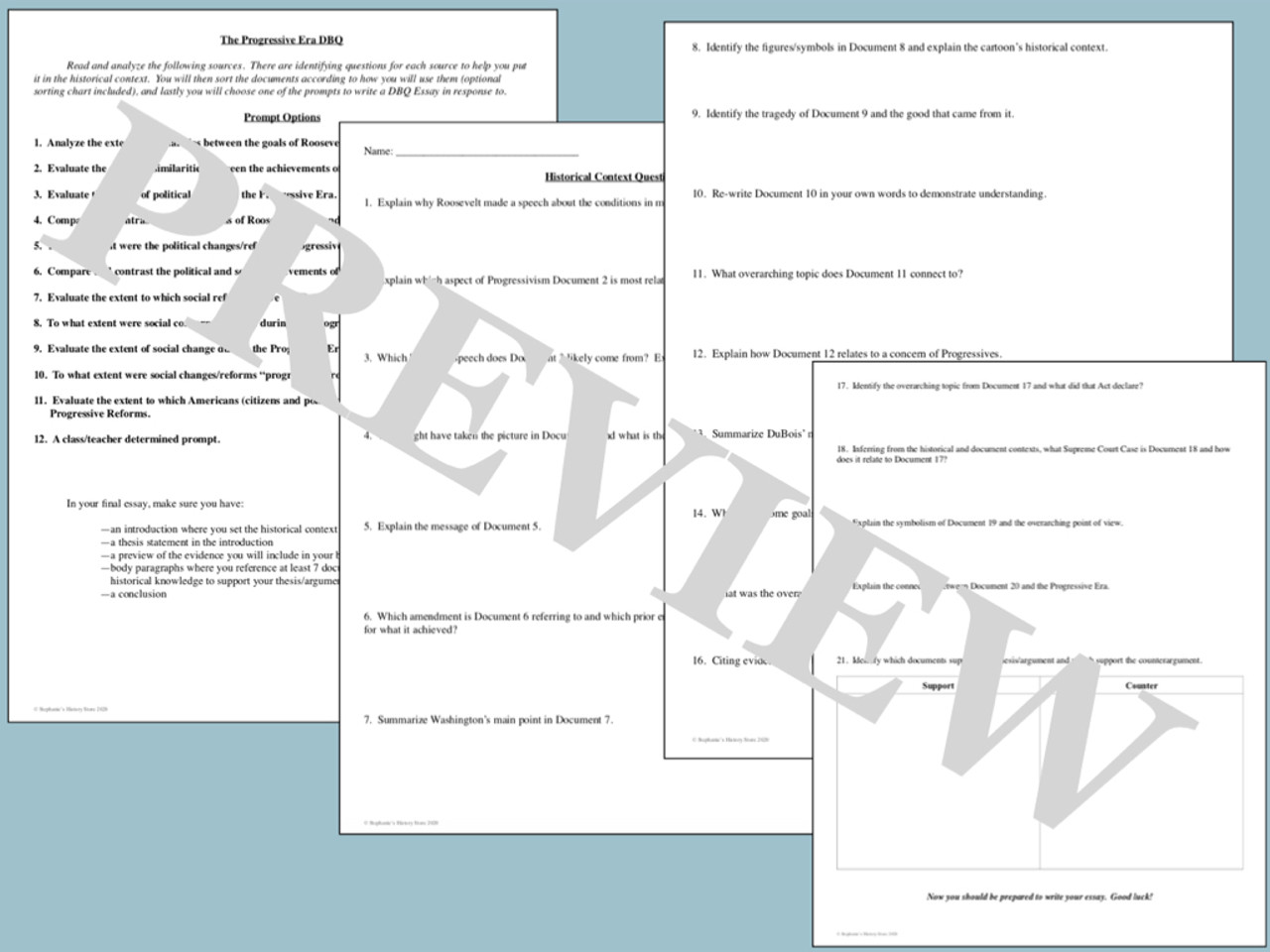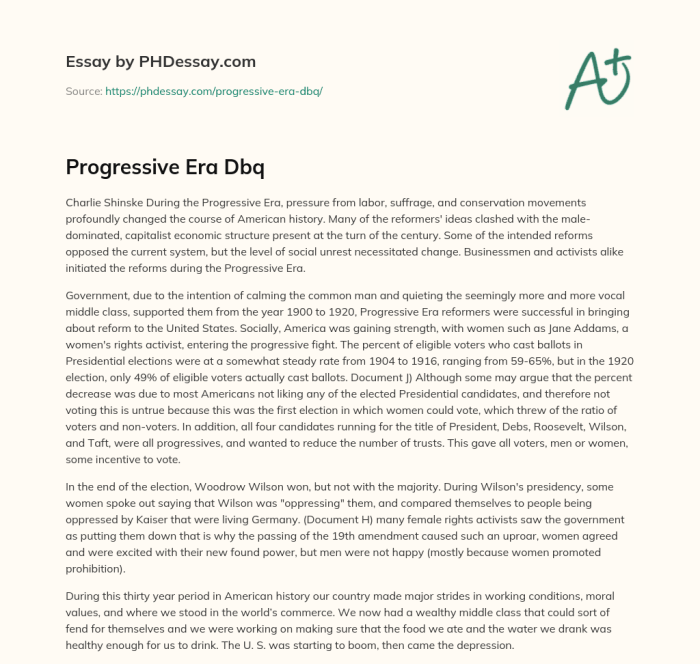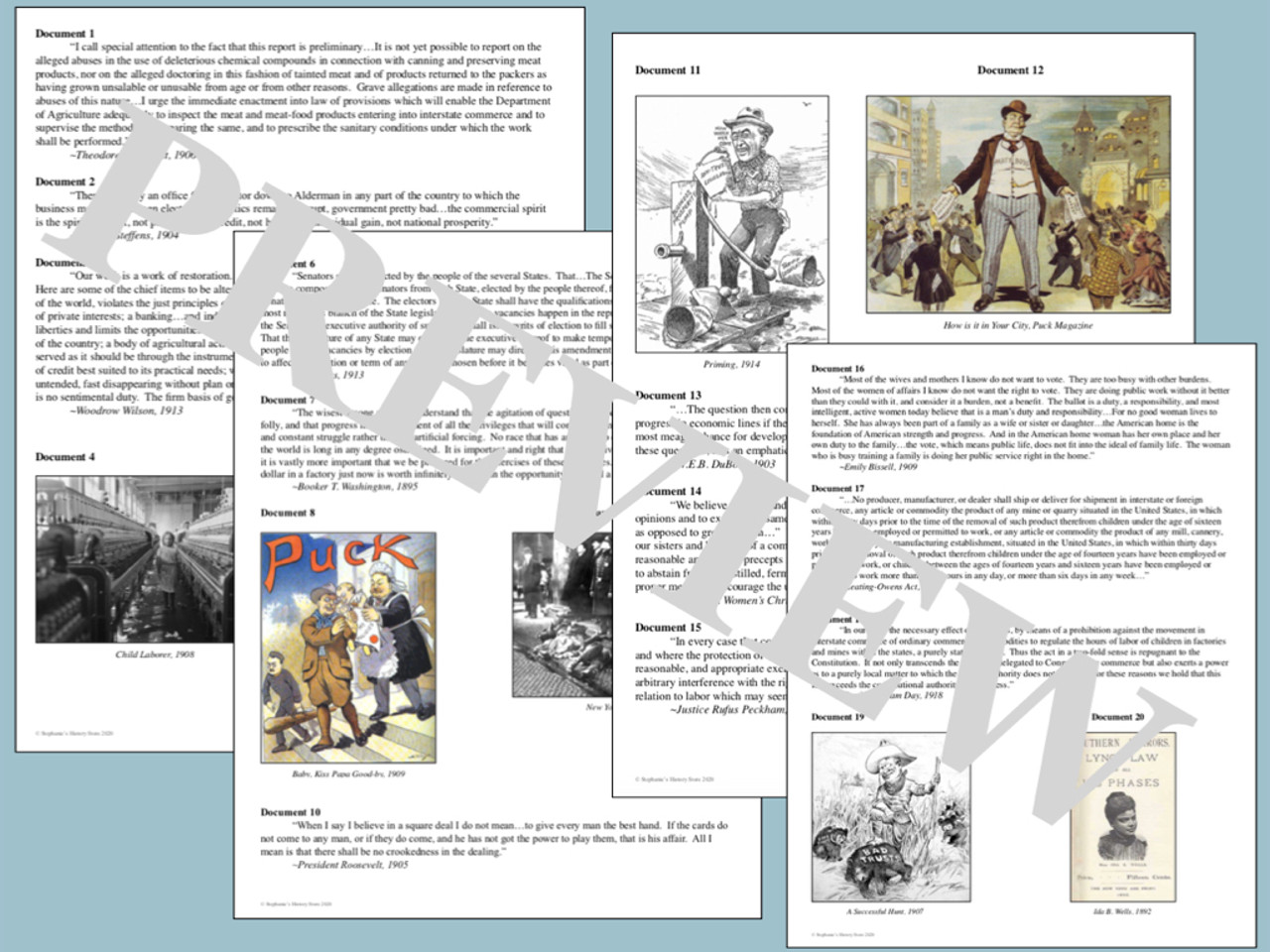Dbq on the progressive era – Prepare yourself for an immersive journey through the Progressive Era, a time of transformative reforms that reshaped the American landscape. As we delve into this era, we’ll explore the driving forces behind its emergence, the key figures who championed change, and the lasting impact it has had on our society.
From social justice to economic regulation, the Progressive Era left an indelible mark on the nation. Join us as we uncover the complexities, controversies, and enduring legacy of this pivotal period in American history.
Historical Context of the Progressive Era
The Progressive Era in the United States emerged during a period of rapid social, economic, and political change in the late 19th and early 20th centuries. The country was experiencing a surge in industrialization, urbanization, and immigration, which brought new challenges and opportunities.
Social Factors, Dbq on the progressive era
- Increased urbanization: Cities grew rapidly, leading to overcrowding, poverty, and social problems.
- Immigration: Millions of immigrants arrived in the US, bringing diverse cultures and perspectives but also straining resources.
- Labor unrest: Industrialization led to the rise of labor unions and strikes, as workers sought better working conditions and wages.
Economic Factors
- Industrialization: The rapid growth of factories and industries transformed the economy and created new wealth but also led to monopolies and economic inequality.
- Corporations: Large corporations gained significant power and influence, often at the expense of consumers and small businesses.
- Financial panics: Economic crises, such as the Panic of 1893, highlighted the need for financial reforms.
Political Factors
- Political corruption: Widespread corruption in government and political machines undermined public trust.
- Ineffective government: The government was often slow to respond to the challenges of industrialization and urbanization.
li>Public outrage: Growing public outrage over social and economic problems led to demands for reforms.
Key Progressive Era Reforms
The Progressive Era, spanning from the late 19th to the early 20th century, witnessed a surge of reform movements aimed at addressing social, economic, and political issues in American society. These reforms were motivated by the growing disparities between the wealthy elite and the working class, concerns over political corruption, and the need for social justice.
Reform Goals and Methods
Progressive reformers shared a common goal of improving the lives of ordinary Americans, particularly the urban working class. Their methods included lobbying for legislation, organizing grassroots movements, and advocating for social change. They believed in using government power to regulate big business, protect workers’ rights, and promote public health.
Table: Progressive Era Reforms
| Reform | Goals | Methods | Outcomes ||—|—|—|—|| Pure Food and Drug Act (1906) | Ensure the safety and purity of food and drugs | Banned the sale of adulterated or mislabeled products | Improved public health and consumer protection || Meat Inspection Act (1906) | Regulate the meatpacking industry to prevent unsanitary conditions | Required federal inspection of meat products | Reduced the incidence of foodborne illnesses || Sherman Antitrust Act (1890) | Break up monopolies and prevent unfair business practices | Prohibited anti-competitive practices such as price-fixing and market domination | Promoted competition and reduced the power of trusts || Federal Reserve Act (1913) | Establish a central banking system to stabilize the economy | Created the Federal Reserve Board to regulate the money supply and interest rates | Improved financial stability and prevented economic crises |
Progressive Era Leaders and Organizations: Dbq On The Progressive Era

The Progressive Era witnessed the rise of influential leaders and organizations dedicated to addressing the social, economic, and political issues of the time. These individuals and groups played a pivotal role in shaping the movement’s agenda and advancing its goals.
Key Leaders
- Theodore Roosevelt: 26th President of the United States, known for his “Square Deal” policies aimed at promoting economic fairness and conservation.
- Woodrow Wilson: 28th President of the United States, implemented progressive reforms such as the Federal Reserve System and the Clayton Antitrust Act.
- William Jennings Bryan: Three-time Democratic presidential candidate, advocated for populist causes and progressive policies, including women’s suffrage.
- Jane Addams: Social reformer and founder of Hull House, a settlement house that provided social services to Chicago’s immigrant community.
- Ida B. Wells-Barnett: Journalist and activist, fought against lynching and racial injustice.
Organizations
In addition to individual leaders, numerous organizations emerged during the Progressive Era, each contributing to the movement in its own way:
- National Association for the Advancement of Colored People (NAACP): Founded in 1909, the NAACP fought for civil rights and equality for African Americans.
- National Consumers League: Advocated for consumer protection and fair labor practices.
- American Civil Liberties Union (ACLU): Founded in 1920, the ACLU defended individual rights and freedoms.
- Settlement Houses: Provided social services and education to urban immigrant communities, including Hull House and Henry Street Settlement.
- Progressive Party: Founded in 1912 by Theodore Roosevelt, the Progressive Party advocated for social justice, economic reform, and environmental conservation.
Impact of the Progressive Era on American Society

The Progressive Era marked a period of profound transformation for American society. The sweeping reforms initiated during this era left an enduring legacy that shaped the country’s political, economic, and social landscape.
Political Landscape
Progressive Era reforms significantly altered the American political system. The introduction of direct primaries, the initiative, and the referendum empowered citizens with greater control over the political process. These reforms weakened the power of political machines and gave rise to a more responsive and accountable government.
- Direct Primaries: Allowed voters to directly select party candidates, bypassing the influence of party bosses.
- Initiative: Granted citizens the right to propose new laws or constitutional amendments through petition.
- Referendum: Empowered voters to approve or reject laws passed by the legislature.
Economic Landscape
The Progressive Era witnessed a significant expansion of government regulation in the economy. Laws such as the Sherman Antitrust Act and the Clayton Act aimed to curb the power of monopolies and promote fair competition. The establishment of the Federal Reserve System brought stability to the financial system and helped prevent economic crises.
- Sherman Antitrust Act (1890): Prohibited the formation of trusts and monopolies.
- Clayton Act (1914): Strengthened antitrust laws and prevented price discrimination and interlocking directorates.
- Federal Reserve System (1913): Centralized control over the monetary system and stabilized the economy.
Social Landscape
Progressive Era reforms had a profound impact on American society. Laws such as the Pure Food and Drug Act and the Meat Inspection Act protected consumers from harmful products. The establishment of the National Park Service preserved natural wonders for future generations.
- Pure Food and Drug Act (1906): Prohibited the sale of mislabeled or adulterated food and drugs.
- Meat Inspection Act (1906): Ensured the safety and cleanliness of meat products.
- National Park Service (1916): Established a system to protect and preserve national parks and monuments.
Controversies and Criticisms of the Progressive Era

The Progressive Era was not without its detractors. Critics argued that the movement was too focused on government intervention and regulation, which they believed stifled individual liberty and economic growth. They also criticized the Progressive Era’s emphasis on social reform, which they saw as an infringement on personal freedom.
When tackling a DBQ on the Progressive Era, it’s essential to explore the social and political dynamics of the time. One such novel that captures this era is “Half of a Yellow Sun” by Chimamanda Ngozi Adichie. Ugwu, the protagonist , embodies the complexities of the era, grappling with his own identity amidst the political turmoil of Nigeria.
Through his journey, we gain insights into the social and economic disparities that shaped the Progressive Era.
Arguments of Opponents
Opponents of Progressive Era reforms argued that:
“Government intervention in the economy stifled innovation and economic growth.”
“Social reforms infringed on personal freedom and undermined traditional values.”
“Progressive Era policies were too expensive and would lead to higher taxes.”
Counterarguments
Proponents of Progressive Era reforms countered these arguments by asserting that:
“Government regulation was necessary to protect consumers and workers from exploitation.”
“Social reforms were essential to address the problems of poverty, inequality, and social injustice.”
“The costs of Progressive Era policies were outweighed by the benefits they brought to society.”
Despite these counterarguments, the Progressive Era remains a controversial period in American history. Critics continue to argue that the movement’s emphasis on government intervention and social reform went too far, while proponents maintain that the Progressive Era was a necessary and positive force for change.
Progressive Era Legacy and Relevance Today

The Progressive Era left a lasting legacy on American society and politics. Its ideas and reforms continue to shape modern-day movements and policies.
Relevance to Contemporary Issues
Progressive Era concerns, such as economic inequality, social justice, and environmental protection, remain relevant today. The Era’s emphasis on government regulation, consumer protection, and labor rights has influenced contemporary debates on these issues.
Inspiration for Modern-Day Movements
Progressive Era ideas have inspired modern-day movements such as the Occupy Wall Street movement, which protested economic inequality, and the environmental movement, which advocates for the protection of natural resources.
Examples of Policies Inspired by the Progressive Era
Policies inspired by the Progressive Era include:
- Social Security, established in the 1930s, provides retirement and disability benefits to Americans.
- The Environmental Protection Agency (EPA), created in 1970, regulates environmental pollution and protects natural resources.
- The Food and Drug Administration (FDA), established in 1906, ensures the safety of food and drugs.
Commonly Asked Questions
What were the major factors that led to the emergence of the Progressive Era?
Industrialization, urbanization, immigration, and political corruption were key factors that sparked the Progressive movement.
Who were some of the most prominent leaders of the Progressive Era?
Theodore Roosevelt, Woodrow Wilson, Jane Addams, and Ida Tarbell were among the influential figures who advocated for Progressive reforms.
What are some examples of the lasting effects of the Progressive Era?
The establishment of the Federal Reserve System, the passage of child labor laws, and the expansion of women’s suffrage are lasting legacies of the Progressive Era.
